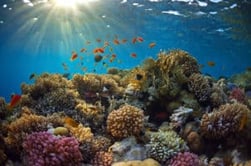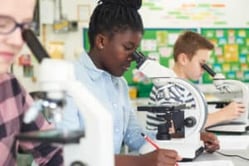Genetic Variation Inquiry Lab
Middle School Inquiry Lab on Genetic Variation
In this lab students will observe organisms as they reproduce, both asexually and sexually, in order to consider which type of reproduction is best.
Each inquiry lab will contain an essential question that will drive the lesson and make students think. For this lesson, the essential question is:
- How are uniform and diverse offspring comparable?
BACKGROUND INFORMATION AND MATERIALS LIST:
Students will begin the lab by reading the essential question and background information. This can be done individually, as lab groups, or as a whole class. If you consider lab groups, you also might include some type of whole class formative checks before digging into the lab.

Materials List:
- yeast water preparation:
- 3/4 teaspoon baker’s yeast
- glass beaker
- 1/4 cup powdered sugar
- 1/2 cup warm water
- 1 teaspoon 3% hydrogen peroxide
- 2 glass slides
- 2 cover slips
- pipette
- colored pencils
PROCEDURE:
For this lab, students will prepare yeast slides and observe the yeast budding during both asexual and sexual types of reproduction. About 10 minutes before the experiment, prepare the yeast water.
First, students will first observe the yeast without stress, which results in asexual reproduction. Students will then be expected to draw what they observe under the microscope on their lab sheet.
Next, students will add a couple drops of hydrogen peroxide to their new slide, to cause stress on the yeast, which results in sexual reproduction. Challenge students to consider the advantages and disadvantages of each type of reproduction.
CHECK FOR UNDERSTANDING:
At this point in the lab, students will be checked for understanding by answering questions about their findings. Here is one that comes with the lab:
- What similarities and differences are there between asexual and sexual reproduction?
CONCLUSION
Students will go back to the essential question and write a CER (Claim, Evidence, Reasoning) to conclude the lab. Once completed, students will reflect back on their learning by answering the following questions:
- What are some advantages and disadvantages of asexual reproduction?
- How are traits passed to offspring during sexual reproduction?
- Yeast is one organism that uses both methods to reproduce. Can you name another?
MODIFIED AND INDEPENDENT INQUIRY VERSIONS
All of the Kesler Science inquiry labs come with three different modification levels. Each lab is differentiated using the icons below.
STANDARDS ALIGNMENT
TEKS: 7.14 B – Compare the results of uniform or diverse offspring from sexual reproduction or asexual reproduction.
NGSS: MS LS4-4 – Construct an explanation based on evidence that describes how genetic variations of traits in a population increase some individuals’ probability of surviving and reproducing in a specific environment.

Download Over $100 in FREE Resources
For Middle School Science
Simply create a login below and gain immediate access to a selection of our Kesler Science product line worth $100 - for FREE. There's a full version of every product type! You'll also join tens of thousands of middle school science teachers who receive timely tips and strategies straight to their inbox.





